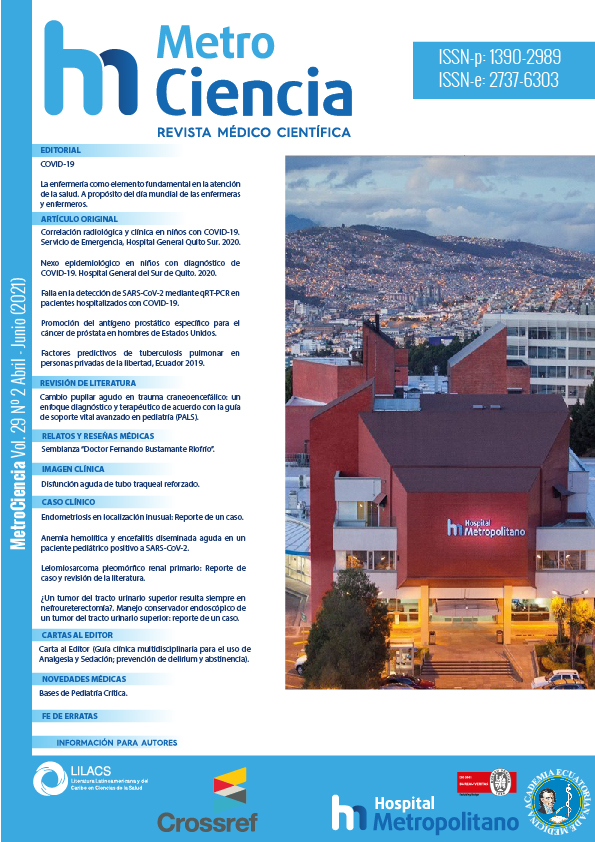Promotion of specific prostate antigen for prostate cancer in adult men in the United States
DOI:
https://doi.org/10.47464/MetroCiencia/vol29/2/2021/32-37Keywords:
Prostate-Specific Antigen, Race Factors, Ethnic Groups, Early Detection of CancerAbstract
Objective: To analyze the association between races/ethnicity and the use of PSA to detect prostate cancer in the US. Method: Observational cross-sectional study. The data used comes from the 2018 Behavioral Risk Surveillance System. Inclusion Criteria: male population residing in the US from Caucasian, African American, and Hispanic race/ethnicity. Exclusion criteria: Men with missing data regarding the variables. Independent variable: race/ethnicity. Dependent variable: Use of the PSA. Confounding Variables: Socioeconomic situation, access to health, information received (advantages, disadvantages, recommendations) about the PSA test by health workers. An adjusted and unadjusted logistic regression was performed calculating odds ratios and a 95% confidence interval. Results: No association was found between race/ethnicity and PSA, OR for Caucasians 1.02 (95% CI 0.95, 1.12), and for Hispanics OR 1.02 (95% CI 0.90, 1.14). The use of the PSA compared to the information received on the advantages of this exam had an OR of 0.19 (95% CI 0.18, 0.20); on disadvantages an OR of 1.06 (95% CI 1.00, 1.13); on recommendations an OR of 0.05 (0.04; 0.05). Access to health and income level had an OR of 0.50 (95% CI 0.46, 0.56) and OR of 1.43 (95% CI 1,36, 1,49), respectively. Conclusions: There was an association between the information provided by health professionals and the use of the PSA, this could encourage the creation of promotional campaigns for the population.
Downloads
References
Vogelzang N, Lee WR, Richie JP. Risk factors for prostate cancer. UpToDate [Internet]. 2019 Jul 9 [cited 2020 Feb 19]. Available from: https://www.uptodate.com/home/ Subscription required.
Hoffman R, Elmore J, O´Leary M, Givens J. Screening for prostate cancer - UpToDate [Internet]. [cited 2020 Feb 19]. Available from: https://www.uptodate.com/contents/screening-for-prostate-cancer?search=prostatecancer&source=search_result&selectedTitle=5~150&usage_type=default&display_rank=5#H1
Elsevier Point of Care. Prostate Cancer Clinical Overview. Elsevier [Internet].2021 May 23 [cited 2021 May 27]. Available from: https://www.clinicalkey.es/ Subscription required.
American Cancer Society. Joinpoint Trends in Cancer Incidence Rates for Selected Sites in Two Age Groups, US, 1995-2015 35 Figure S6. Trends in Cancer Death Rates for Selected Sites [Internet]. 2019 [cited 2020 Feb 19]. Available from: https://www.cancer.org/content/dam/cancer-org/research/cancer-facts-and-statistics/annual-cancer-facts-and-figures/2019/cancer-facts-and-figures-2019.pdf
Elmore JG, O´Leary MP. Screening for prostate cancer. UpToDate [Internet]. 2020 Jan 20 [cited 2020 Feb 19]. Available from: https://www.uptodate.com/home/ Subscription required.
Henderson RJ, Eastham JA, Culkin DJ, Kattan MW, Whatley T, Mata J, et al. Prostate-specific antigen (PSA) and PSA density: Racial differences in men without prostate cancer. J Natl Cancer Inst. 1997;89(2):134–8
Goldman L, Schafer AI. Goldman-Cecil. Tratado de medicina interna. 25th ed. Barcelona: Elsevier; 2017
Cancer.org [Internet]. American Cancer Society; c 2019 [cited 2020 Feb 22]. American Cancer Society Recommendations for Prostate Cancer Early Detection; [about 2 screens]. Available from: https://www.cancer.org/cancer/prostate-cancer/detection-diagnosis-staging/acs-recommendations.html
Niederhuber JE, Armitage JO, Doroshow JH, Kastan MB, Tepper JE. Abeloff's Clinical Oncology. 6th ed. Barcelona: Elsevier; 2020.
Prieto JM, Yuste JR. Balcells. La clínica y el laboratorio. 23rd ed. Barcelona: Elsevier; 2019.
Partin AW, Dmochowski RR, Kavoussi LR, Peters CA. Campbell-Walsh-Wein Urology. 12th ed. Philadelphia: Elsevier; 2021.
Zhang H, Messing EM, Travis LB, Hyrien O, Chen R, Milano MT, et al. Age and racial differences among PSA-detected (AJCC stage T1cN0M0) prostate cancer in the U.S.: A population-based study of 70,345 men. Front Oncol. 2013;3 DEC(December):1–10
Turini GA, Gjelsvik A, Renzulli JF. The State of Prescreening Discussions About Prostate-specific Antigen Testing Following Implementation of the 2012 United States Preventive Services Task Force Statement. Urology [Internet]. 2017 Jun 1 [cited 2020 Jun 24];104:122–30. Available from: https://linkinghub.elsevier.com/retrieve/pii/S0090429517302467
National Institute for Health and Care Excellence [Internet]. Prostate cancer: diagnosis and management (NG131). Available from: https://www.elsevier.com/solutions/clinicalkey
Fleshner K, Carlsson SV, Roobol MJ. The effect of the USPSTF PSA screening recommendation on prostate cancer incidence patterns in the USA. Nat Rev Urol. 2017 Jan;14(1):26-37.
Jemal A, Fedewa SA, Ma J, Siegel R, Lin CC, Brawley O, Ward EM. Prostate Cancer Incidence and PSA Testing Patterns in Relation to USPSTF Screening Recommendations. JAMA. 2015 Nov 17; 314(19):2054-61.
Sammon JD, Dalela D, Abdollah F, Choueiri TK, Han PK, Hansen M, Nguyen PL, Sood A, Menon M, Trinh QD. Determinants of Prostate Specific Antigen Screening among Black Men in the United States in the Contemporary Era. J Urol. 2016 Apr;195(4 Pt1): 913-8.
Vertosick EA, Poon BY, Vickers AJ. Relative value of race, family history and prostate specific antigen as indications for early initiation of prostate cancer screening. J Urol. 2014 Sep;192(3):724-8.
Hudson MA, Luo S, Chrusciel T, Yan Y, Grubb RL 3rd, Carson K, Scherrer JF. Do racial disparities exist in the use of prostate cancer screening and detection tools in veterans? Urol Oncol. 2014 Jan; 32(1):34.e9-18.
cdc.gov [Internet]. Centers for Disease Control and Prevention; c 2019 [cited 2020 Mar 20]. Behavioral Risk Factor Surveillance System; [about 3 screens]. Available from: https://www.cdc.gov/brfss/index.html
Published
How to Cite
Issue
Section
License
Copyright (c) 2021 Ana Paula González Avilés, Emily Valeria Paredes Gordón

This work is licensed under a Creative Commons Attribution-NonCommercial-NoDerivatives 4.0 International License.











